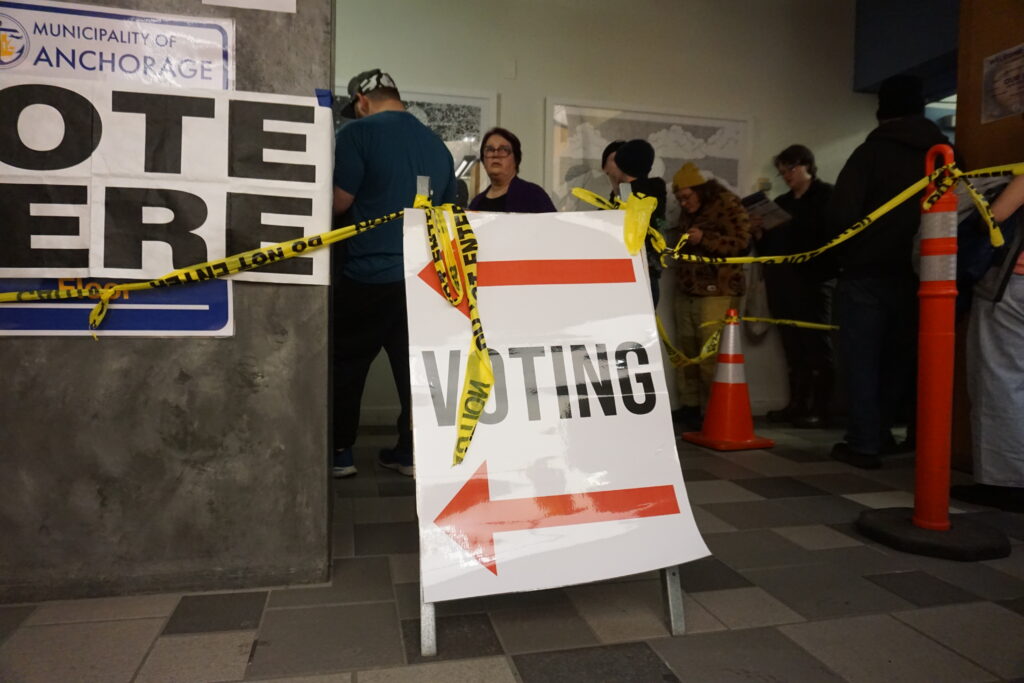![]()
Voters line up in the lobby of Anchorage’s City Hall on Monday, with most waiting 90 minutes to two hours that morning to cast their ballots at the early voting site there. Early voting in Alaska was much more popular this year than in past election years, state statistics show. (Photo by Yereth Rosen/Alaska Beacon)
Alaskans this year made a dramatic shift from past years in their voting practices, choosing in large numbers to cast their ballots before Election Day rather than on Tuesday.

As of Sunday, 61,912 Alaskans had voted early, according to the Alaska Division of Elections statistics that did not include totals from Monday, the last day of early voting. That compares to 38,242 early voters in the 2016 general election and 19,937 early voters in the 2012 general election, according to the division’s statistics. This year’s early vote tally has surpassed even that of 2020, when voters opted for alternative ways to cast their ballots because of the COVID-19 pandemic, according to the division’s statistics.
This year’s heavy early voting trend resulted in long lines and long delays, with queues that sometimes snaked around buildings, causing people to endure some blustery weather as they waited. In some cases, the waits extended for hours.
Among those spending a lot of time in line was U.S. Rep. Mary Peltola, D-Alaska, who waited nearly two hours to cast her ballot on Monday at Anchorage City Hall. The lobby was packed when she was there, and there were other problems, including a clogged toilet in the women’s restroom.

Because electioneering is prohibited at polling sites, she wound up with a welcomed break from politics talk, she said. As she moved through the line, she sipped a hot chocolate, one in a batch of hot drinks bought for the candidate and campaign staff members by aide Anton McParland.
She did not want any coffee right then, she said. “My nerves don’t need any caffeine boost right now,” she said.
Nick Begich, her Republican opponent, also voted early on Monday. He faced a shorter wait – about 40 minutes – but noted that he arrived at 7:50 a.m., 10 minutes before the polling site at the Eagle River Town Center opened. There was already a line that early in the morning, he said.
There are good reasons to vote early, Begich said.

“If you’re 90% sure you’ll vote on Election Day, you can be 100% sure if you vote early,” he said after eating an Election Day lunch at Jackie’s Place, a diner in West Anchorage’s Spenard neighborhood. Waiting until Election Day to vote creates a risk of unexpected obstacles like bad weather or health problems, he said. “There might be life-event things that come up,” he said.
Like Peltola, he said the high degree of early voting may have come as a surprise. “I don’t think anyone expected to see the level of early voting that we did see in this election,” he said.
Though there were numerous sites around the state set up for early voting, it might be a good idea to have more such sites in future elections, Begich said.
There was at least one beneficiary of the early voting rush: City Grind, the coffee shop in the lobby of City Hall.

Owner Kim Lemish said the café brought in $200 or more in extra revenue each day during the two-week period of early voting at City Hall. “Lots of lattes, breves, muffins, cookies, breakfast sandwiches,” she said. Her normal closing time is 3 p.m., but she stayed open a little past then if there were lines, she said,
Affixed to a plastic panel at her counter is one of the Tlingit art “I Voted” stickers, which she got on Oct. 21, the first day of early voting. That day, she walked across the lobby to fill out her ballot, she said.
“On that Monday, it was so busy,” she said. But her husband, who works upstairs in City Hall, alerted her about a break in the queue, she said. “He said, ‘OK, go vote now, because there’s no line.’”
GET THE MORNING HEADLINES.

